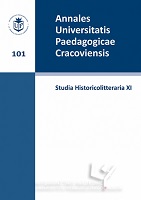Codzienność i świętowanie. Władysława Orkana twórczość dla młodzieży
Everyday life and celebration. Władysław Orkan’s works for the young
Author(s): Zofia BudrewiczSubject(s): Studies of Literature, Polish Literature, Sociology of Literature
Published by: Wydawnictwo Uniwersytetu Komisji Edukacji Narodowej w Krakowie
Keywords: Władysław Orkan; young; everyday life; celebration; children's literature;
Summary/Abstract: The aim of the article was to analyse the origin and functions of Władysław Orkan’s writing addressed to the school-age young people from the interwar period and includes 17 novelettes and sketches, 13 of which were published in student anthologies. The works were commissioned by the authors of interwar textbooks of literary and cultural education in mainstream and grammar schools. Their comparison with manuscripts (preserved in the Jagiellonian Library in Cracow) shows how heavily the works’ final versions were influenced by the objectives of the Polish language education and how difficult it sometimes was for Orkan to match the requirements of the editors. Works which were the most interesting from the artistic point of view were published in 1936 outside the school system by Stanisław Pigoń. Thirty years later, a team under his supervision decided to publish all sketches. At present, as the most interesting should be regarded the works depicting the social and moral realities of the Podhale countryside (e.g. Dyzma w Betlejem, Legenda o Podhalu) as well as novelettes in which the mountain nature was treated as a literary character of an equal rank (e.g. Zła zima, Orły, Owce w burzy). The author associated each of those thematic movements with specific educational objectives. Sometimes he overstated them (Prządki, Prędki Michał) or did not manage to find a proper artistic idea (sketches with children main characters: Jaś w Chochołowie, Przygoda Wojtusia, Jędruś na weselu). It is currently difficult to promote such texts as reading for young people. Reception research on the remaining works shows that they are still lively received. That is why it is worth to restore them to the reader for whom they were created.
Journal: Annales Universitatis Paedagogicae Cracoviensis. Studia Historicolitteraria
- Issue Year: 2011
- Issue No: 11
- Page Range: 120-131
- Page Count: 12
- Language: Polish

